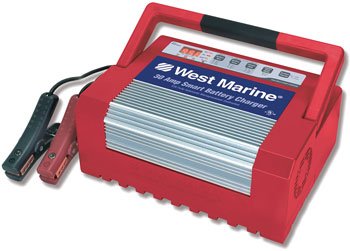Advertisement

Battery Chargers
Experts agree that the best way to replace the energy you consume from your boat's batteries is through a controlled, multi-stage process. Conventional lead-acid (flooded) batteries, gel cells, AGM batteries and other recently developed battery types will charge faster, better and last longer if they are charged in distinct phases that take into account their chemical and physical characteristics. A typical three-stage charging process for a wetted lead acid deep cycle battery works as follows:
Bulk Stage
This first stage provides a constant amperage bulk charge, usually of 25-40% of the battery's capacity (in amp hours, Ah) up to about 14.4 volts (14.2 for gel cells). This bulk charge will restore about 75% of the battery's total capacity. It takes less time than other less expensive chargers such as ferroresonant chargers, because the smart charger delivers greater current to the batteries during the time that they can accept greater current loads because of the degree of their discharge.
Absorption Stage
The remaining 25% of capacity is restored at a decreasing rate. Maintaining the battery at about 14.4 volts (14.2 for gel), the amperage is steadily reduced. The battery is considered fully charged when it will accept only 2-4% of its amp-hour capacity at 14.4 volts.
Float Phase
The charge amperage has declined to 2-4% of the battery's capacity, and voltage drops to a maintenance level which maintains the battery without losing electrolyte from gassing. The charger will increase charge commensurate with discharge when 12 V draw occurs as if from refrigeration, electronics, inverter etc..
Equalization
Applies to lead-acid batteries only. This fourth, manually triggered stage, prevents lead-acid batteries from aging prematurely by applying a small, constant current until the battery reaches a relatively high voltage, (often around 16 volts) which removes the hardened lead sulfate crystals on the battery plates and prolongs battery life. During the equalization process all DC users should be turned off to avoid damage from high voltage. The liquid in the battery will emit small bubbles. It is "gassing." This requires very good ventilation during the process and the liquid level should be checked and topped up after the process. While most chargers automatically cut off after a pre-programmed point in the equalization phase, their instructions also typically recommend checking the specific gravity of each battery cell to assure proper equalization. This process, as you can see, requires careful following of the instructions and other safety measures.
Advertisement
Types and Use of Chargers
You should use only marine grade smart AC chargers on your boat. These will, when working properly and after being set up properly, charge and maintain your batteries automatically. Non marine ferroresonant type of chargers typically sold in auto parts stores or mechanical sections of large stores shouldn't be used aboard a boat unless specifically rated for marine use. They are less expensive and may appear more robust, but they utilize heavy windings rather than more complex technology, are heavier and can cause problems on boats. Chargers that aren't designed for marine use may lead to unseen but damaging electrical problems on boats.
Different types of batteries have different parameters as to charging. A truly smart charger can be set by the user or installer to tailor the charging to suit the bank as to size and type, temperature, ambient temperature and other parameters. For example, charging an AGM or Gel battery with the same charging parameters as appropriate for a wetted lead acid deep cycle battery would seriously damage those batteries. Separate banks should be charged separately. Even if the different banks are of the same type they should still be charged separately unless their size and usage history is the same — which is almost never the case. Many prefer to insure that this is done by manually selecting a bank for charging by simply changing the battery selector switch to shunt charging current to the desired bank, if the boat is wired for this.
There are now battery chargers available that will charge and maintain up to three or four different banks of batteries, each of a different construction type. For example, one of these chargers could handle a bank of wetted lead acid deep cell batteries, a bank of AGMs and a bank of gel cells. This is typically accomplished by what is essentially a round robin approach, handled electronically. The charger skips from bank to bank, quickly senses its state, and does what it needs to do for that bank. If one bank is much more deeply discharged than another, it will "pay more attention" to that bank until it is up to par, but still keep monitoring the other banks. Of course, the user or installer must tell the charger (via settings) the type (and with some sets, certain other desired charging parameters) of each separate bank that it will be servicing.
Many inverters on the market also charge batteries. This makes sense because certain of the components to charge and certain of the components to invert are the same, therefore it is cost and space effective to have one unit do both jobs. Find more information in our Inverters article.
Of course, you will also be charging batteries with one or more alternators on your boat. See our article on 12 Volt Electrical Systems for more information on this subject.
Battery chargers may produce high current. Some stronger chargers seen on boats today can pump in over 100 amps DC current into the batteries. This requires robust wires, terminals and fuses and careful wiring, all according to manufacturer instructions. Scrimping here can cause fires. All chargers should be installed and maintained following the manufacturer's instructions and according to applicable ABYC standards.
Technology, knowledge and practices change almost daily therefore it is prudent to research for the very latest up to the date information and seek qualified professional assistance when needed.
